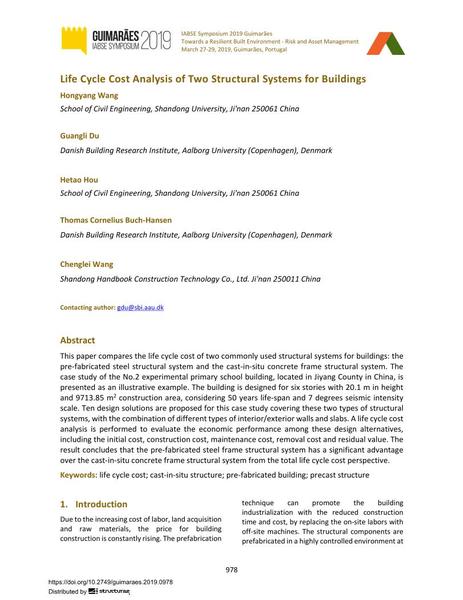Life Cycle Cost Analysis of Two Structural Systems for Buildings

|
|
|||||||||||
Bibliografische Angaben
| Autor(en): |
Hongyang Wang
(School of Civil Engineering, Shandong University, Ji'nan 250061 China)
Guangli Du (Danish Building Research Institute, Aalborg University (Copenhagen), Denmark) Hetao Hou (School of Civil Engineering, Shandong University, Ji'nan 250061 China) Thomas Cornelius Buch-Hansen (Danish Building Research Institute, Aalborg University (Copenhagen), Denmark) Chenglei Wang (Shandong Handbook Construction Technology Co., Ltd. Ji'nan 250011 China) |
||||
|---|---|---|---|---|---|
| Medium: | Tagungsbeitrag | ||||
| Sprache(n): | Englisch | ||||
| Tagung: | IABSE Symposium: Towards a Resilient Built Environment Risk and Asset Management, Guimarães, Portugal, 27-29 March 2019 | ||||
| Veröffentlicht in: | IABSE Symposium Guimarães 2019 | ||||
|
|||||
| Seite(n): | 978-985 | ||||
| Anzahl der Seiten (im PDF): | 8 | ||||
| DOI: | 10.2749/guimaraes.2019.0978 | ||||
| Abstrakt: |
This paper compares the life cycle cost of two commonly used structural systems for buildings: the pre-fabricated steel structural system and the cast-in-situ concrete frame structural system. The case study of the No.2 experimental primary school building, located in Jiyang County in China, is presented as an illustrative example. The building is designed for six stories with 20.1 m in height and 9713.85 m² construction area, considering 50 years life-span and 7 degrees seismic intensity scale. Ten design solutions are proposed for this case study covering these two types of structural systems, with the combination of different types of interior/exterior walls and slabs. A life cycle cost analysis is performed to evaluate the economic performance among these design alternatives, including the initial cost, construction cost, maintenance cost, removal cost and residual value. The result concludes that the pre-fabricated steel frame structural system has a significant advantage over the cast-in-situ concrete frame structural system from the total life cycle cost perspective. |
||||
